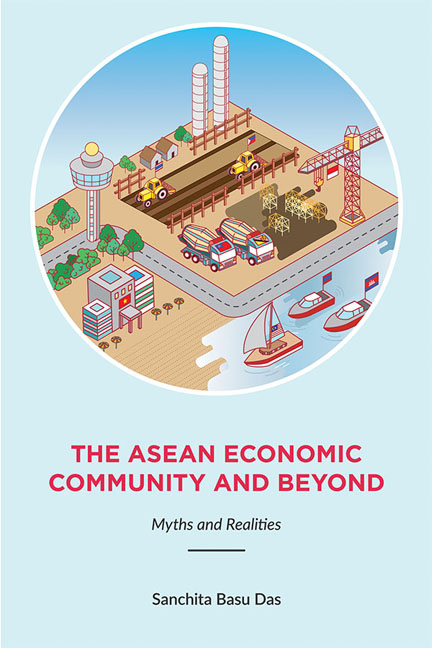Book contents
- Frontmatter
- Dedication
- Contents
- Foreword
- Acknowledgements
- Abbreviations
- 1 Introduction: The ASEAN Economic Community and Beyond
- I THE ASEAN ECONOMIC COMMUNITY (AEC)
- II BEYOND THE ASEAN ECONOMIC COMMUNITY
- 9 The Regional Comprehensive Economic Partnership: Going Beyond ASEAN+1 FTAs
- 10 Comparing ASEAN+1 FTAs for an Effective RCEP
- 11 Challenges in Negotiating the Regional Comprehensive Economic Partnership Agreement
- 12 The Next Decade in ASEAN-U.S. Economic Relations
- 13 RCEP and TPP: Comparisons and Concerns
- 14 The Trans-Pacific Partnership (TPP): Economic and Strategic Implications for the Asia-Pacific
- 15 The Trans-Pacific Partnership as a Tool to Contain China: Myth or Reality?
- 16 RCEP and TPP: Can They Converge into an FTAAP?
- 17 Is APEC's Relevance Fading?
- III AN ASEAN PERSPECTIVE OF REGIONAL CONNECTIVITY
- Appendix: Summary of the Trans-pacific Partnership Agreement
- Index
- About the Author
15 - The Trans-Pacific Partnership as a Tool to Contain China: Myth or Reality?
from II - BEYOND THE ASEAN ECONOMIC COMMUNITY
Published online by Cambridge University Press: 19 May 2017
- Frontmatter
- Dedication
- Contents
- Foreword
- Acknowledgements
- Abbreviations
- 1 Introduction: The ASEAN Economic Community and Beyond
- I THE ASEAN ECONOMIC COMMUNITY (AEC)
- II BEYOND THE ASEAN ECONOMIC COMMUNITY
- 9 The Regional Comprehensive Economic Partnership: Going Beyond ASEAN+1 FTAs
- 10 Comparing ASEAN+1 FTAs for an Effective RCEP
- 11 Challenges in Negotiating the Regional Comprehensive Economic Partnership Agreement
- 12 The Next Decade in ASEAN-U.S. Economic Relations
- 13 RCEP and TPP: Comparisons and Concerns
- 14 The Trans-Pacific Partnership (TPP): Economic and Strategic Implications for the Asia-Pacific
- 15 The Trans-Pacific Partnership as a Tool to Contain China: Myth or Reality?
- 16 RCEP and TPP: Can They Converge into an FTAAP?
- 17 Is APEC's Relevance Fading?
- III AN ASEAN PERSPECTIVE OF REGIONAL CONNECTIVITY
- Appendix: Summary of the Trans-pacific Partnership Agreement
- Index
- About the Author
Summary
The Trans-Pacific Partnership (TPP) is envisioned to be a “comprehensive and high-quality” FTA to liberalize trade in goods and services, encourage investments, promote innovation, economic growth and development and support job creation and retention. The absence of China in the TPP negotiations has led many to speculate that the TPP is an economic tool for the United States to contain China's rise in East Asia. However, the evolution of TPP does not indicate any such intention. Moreover, China and the current TPP members have strong trade linkages. TPP can be seen as a regional initiative where member countries have to follow certain guidelines and standards for conducting economic activities so as to ensure a level playing field for interested parties. In the short run, China is more likely to be abstain from the TPP agreement as it may not be ready to uphold the types of obligations currently negotiated in the agreement. Other than that, China will continue with its efforts to deepen economic cooperation with its Asia-Pacific neighbours. These can act as “building blocks” for deeper FTAs with TPP signatories in the future.
INTRODUCTION
Since the framework of the Trans-Pacific Partnership (TPP) Agreement with nine Asia-Pacific economies was launched in 2011, the negotiations were joined by Canada and Mexico in December 2012. Japan expressed its definitive interest to join the TPP negotiations in March 2013, which the United States supported in an April 2013 meeting. These twelve economies constituted 38 per cent (US$27.6 trillion) of world GDP, 26 per cent of world trade (US$9.6 trillion) and 11 per cent (792 million) of world population in 2012. Negotiators envision the TPP to be a “comprehensive and highquality” FTA that aims to liberalize trade in goods and services, encourage investments, promote innovation, economic growth and development and support job creation and retention.
The TPP has twenty-nine chapters, including topics like market access for goods and services, agriculture, financial services, telecommunication, Intellectual Property Rights (IPR), Rules of Origin (ROO), Technical Barriers to Trade (TBT), sanitary and phyto-sanitary standards (SPS), foreign investment, competition policy, trade remedies, transparency in health care technology and pharmaceutical, labour, environment, regulatory coherence, government procurement, state owned enterprises (SOEs), e-commerce, small and medium scale enterprises, secretariat, dispute settlement and few others.
- Type
- Chapter
- Information
- The ASEAN Economic Community and BeyondMyths and Realities, pp. 157 - 164Publisher: ISEAS–Yusof Ishak InstitutePrint publication year: 2015



